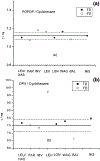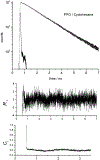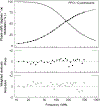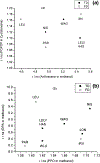Fluorescence lifetime standards for time and frequency domain fluorescence spectroscopy
- PMID: 17269654
- PMCID: PMC6816264
- DOI: 10.1021/ac062160k
Fluorescence lifetime standards for time and frequency domain fluorescence spectroscopy
Abstract
A series of fluorophores with single-exponential fluorescence decays in liquid solution at 20 degrees C were measured independently by nine laboratories using single-photon timing and multifrequency phase and modulation fluorometry instruments with lasers as excitation source. The dyes that can serve as fluorescence lifetime standards for time-domain and frequency-domain measurements are all commercially available, are photostable under the conditions of the measurements, and are soluble in solvents of spectroscopic quality (methanol, cyclohexane, water). These lifetime standards are anthracene, 9-cyanoanthracene, 9,10-diphenylanthracene, N-methylcarbazole, coumarin 153, erythrosin B, N-acetyl-l-tryptophanamide, 1,4-bis(5-phenyloxazol-2-yl)benzene, 2,5-diphenyloxazole, rhodamine B, rubrene, N-(3-sulfopropyl)acridinium, and 1,4-diphenylbenzene. At 20 degrees C, the fluorescence lifetimes vary from 89 ps to 31.2 ns, depending on fluorescent dye and solvent, which is a useful range for modern pico- and nanosecond time-domain or mega- to gigahertz frequency-domain instrumentation. The decay times are independent of the excitation and emission wavelengths. Dependent on the structure of the dye and the solvent, the excitation wavelengths used range from 284 to 575 nm, the emission from 330 to 630 nm. These lifetime standards may be used to either calibrate or test the resolution of time- and frequency-domain instrumentation or as reference compounds to eliminate the color effect in photomultiplier tubes. Statistical analyses by means of two-sample charts indicate that there is no laboratory bias in the lifetime determinations. Moreover, statistical tests show that there is an excellent correlation between the lifetimes estimated by the time-domain and frequency-domain fluorometries. Comprehensive tables compiling the results for 20 (fluorescence lifetime standard/solvent) combinations are given.
Figures





References
-
- Demas JN Excited-State Lifetime Measurements; Academic Press: New York, 1983.
-
- Cundall RB, Dale RE, Eds. Time-resolved Fluorescence Spectroscopy in Biochemistry and Biology; Plenum Press: New York, 1983.
-
- O’Connor DV; Phillips D Time-correlated Single Photon Counting; Academic Press: London, 1984.
-
- van Hoek A; Visser AJWG Anal. Instrum 1985, 14, 359–378.
-
- Jameson DM; Gratton E; Hall RD Appl. Spectrosc. Rev 1984, 20, 55–106.
Publication types
MeSH terms
Substances
Grants and funding
LinkOut - more resources
Full Text Sources
Other Literature Sources
Miscellaneous

